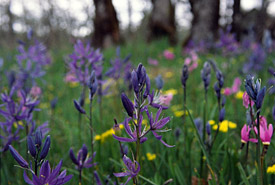Cowichan Garry Oak Preserve
Due to the elevated wildfire risk across British Columbia, some of NCC’s conservation areas are currently closed to public access. Please check our Current Fire Closures page for more information.

Cowichan Garry Oak Preserve flowers, BC (Photo by Tim Ennis/NCC)
Large, gnarled oaks stand guard in the Cowichan Garry Oak Preserve (CGOP), weathering the wind and rain of West Coast winters. They provide shelter for gartersnakes, black-tailed deer and a variety of birds. In the surrounding meadows, bees hum around native wildflowers and plants, such as camas, chocolate lily and Howell's triteleia. Meanwhile, a small creek bears fish through a stand of mature Douglas-fir and down to the Quamichan wetlands. There, at the edge of Quamichan Lake, rest flocks of migratory birds and tree frogs nestled in the branches.
These trees were once common throughout southeastern Vancouver Island, the Gulf Islands and down through the Puget Trough of Washington State and Oregon's Willamette Valley. However, the spread of urban and agricultural development in the last 150 years has eliminated these Garry oak ecosystems to less than five per cent of their historical extent. The Cowichan Valley is widely known as one of the last and best havens in Canada of the globally endangered ecosystem and its biodiversity. The Cowichan Garry Oak Preserve occupies a vital part of this ecological tapestry.
Since its establishment in 1999, CGOP has been a hub of activity for both restoration and research work in the Cowichan Valley. The ongoing and enthusiastic support from the local community continues to ensure the vitality of this precious conservation area.
Ecological significance
While so little of this ecosystem remains in a natural state, more than 100 species at risk still depend on it. Garry oak ecosystems support the highest diversity of plants in coastal British Columbia. They also support a high diversity of insects, reptiles and birds. The complex structure of these woodlands and meadows creates a variety of habitat. The area supports species such as Cooper's hawk, great horned owl, yellow montane violet and more than 100 types of native bees.
In 2012, CGOP was chosen as the first site for the reintroduction of western bluebirds to Vancouver Island. The Bring Back the Bluebirds project is a multi-partner species-recovery initiative with the goal of re-establishing a breeding population of western bluebirds on southern Vancouver Island and the Gulf Islands.
With only pockets of Garry oak ecosystems remaining, the species that rely on them are in rapid decline as well. Scientists are scrambling to understand the intricacies of these ecosystems and the vast complex of plants and animals found in them. Over the past two decades, CGOP has hosted a number of research scientists from across North America to conduct studies that further our collective understanding of Garry oak ecosystems. Their work contributes to NCC's and other organization's ongoing efforts to restore Garry oak ecosystems in the Pacific Northwest.
Cultural significance
Garry oak meadows have been integral to the First Nations of the Cowichan Valley for thousands of years. Camas was cultivated in the meadows and harvested in late summer for its bulb, which is rich in carbohydrates and was pit-cooked or dried and ground up to make flour. In order to ensure the vibrant blue-purple flower thrived, Indigenous communities worked with natural systems. At times they performed prescribed burns to limit shrubs and conifers from expanding into meadows with deep soil.
Conservation history
NCC acquired the land that is now the Cowichan Garry Oak Preserve in 1999, with notable support from the local community. At the time the property was being considered for subdivision and development. NCC’s purchase of this land, along with the additional purchase of a neighbouring parcel in 2001, represented a significant win for the conservation of Garry oak ecosystems in Canada. Today this land is considered to be one of the last best remnants of deep soil Garry oak habitat in the region, protecting 33 hectares of meadow, forest and wetland habitats.
Listen to our podcast and transport yourself to this important natural area. Learn about NCC’s conservation work here.
Restoring the meadows
When NCC became stewards of the Cowichan Garry Oak preserve, the meadows were largely choked with invasive Scotch broom and other invasives. Restoration efforts are allowing native vegetation to re-establish across the preserve. Volunteers have been instrumental in helping to restore the meadows and to tend a native plant nursery, which supports the ongoing stewardship of this special place.
This work has enhanced the presence of many native plants, including the endangered Howell’s triteleia, which covers the meadows with a dusting of purple each spring. Pressure from invasive species caused the number of the delicate purple flowering plants to drop to as low as 200 on CGOP. But thanks to restoration efforts, 600 Howell’s triteleia were recorded in 2018 in a single restored section of the preserve.
Prescribed burns
NCC has completed multiple prescribed burns at the Cowichan Garry Oak Preserve, aided by knowledge of traditional practices from the Cowichan Tribes.
The woodlands and wildflower meadows of Garry oak ecosystems rely on the occasional low-intensity fire to burn away encroaching shrubs and trees. Historically, lightning would start some fires naturally. More common was the intentional use of fire by Indigenous communities. For centuries, Coast Salish Peoples burned Garry oak meadows to promote the growth of edible root crops — notably camas — and to eliminate competing shrubs and trees. This burning also enhanced food for deer and elk, which supported hunting and reduced insects, pests and diseases.
European settlement in the mid-1800s introduced widespread fire suppression, which, along with land conversion, led to a significant loss of Garry oak ecosystems and the unique plants and animals that rely on it. Remaining Garry oak meadows were steadily filled in with shrubs and forest trees (particularly Douglas-fir).
Today, land managers are looking at ways of reintroducing fire to the landscape in order to avoid further loss of Garry oak meadows, and to enhance the natural resiliency of this unique ecosystem.




